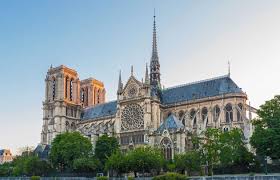Like most of the world, I was saddened by the devastating fire that did so much damage to Notre Dame Cathedral in Paris last month. You don’t have to have been to this magnificent building, nor do you have to be religious, to be heartened that the damage was contained and the building will be fully restored.

Once it was out of the news, I didn’t give much of a thought to Notre Dame. That is, until I saw an article in EE Times in which they asked Jon Peddie, a 3D expert, and asked him:
If you were contacted by Anne Hidalgo, mayor of Paris, and asked for a list of technologies needed to restore Notre Dame, what would be your advice to her?
Peddie’s initial answer was to ask question of his own: how closely would the restoration have to stick to the original. E.g., could they replace oak beams with fire proof titanium. Then he started his tick list of the approach he’d take and what technology he’d deploy:
- An eight-corner laser scan (inside and out) that would be used to generate CAD drawings to compare to whatever original design drawings are available.
- “A multi-frequency ultrasonic scan to find any weak, cracked, crumbling, or missing mortar. Those interfaces will be the weak links in reconstruction and need attention before any new construction starts.”
- Multiple high rez photos of the stained-glass windows, using HDR stereo-depth cameras attached to drones. Glaziers would use these to restore (clean, restructure, and repair) the glass.
- Ray-tracing techniques so that “the lighting conditions of the building before the fire can be recreated.”
- Digitize all data that’s available on the building, from original diagrams to files pertaining to any of the earlier restoration efforts.
- Put out the word via social media to have people send int their photos of the cathedral’s interior. Then, use AI software to “catalog and create 3D models of everything” so that everything – down to the door knobs and hinges – can be replicated.
- Tap the 3D models that Ubisoft used for its Assassins Creed game.
That got me doing a little looking around for other articles on the technology. While looking around, I came across a piece in The Atlantic that talked about Andrew Tallon, an architectural historian (who died last November at the age of 49), who in 2010, alongside colleague Paul Blaer, did an ultra-detailed scan of Notre Dame:
They mounted the Leica on a tripod, put up markers throughout the space, and set the machine to work. Over five days, they positioned the scanner again and again—50 times in all—to create an unmatched record of the reality of one of the world’s most awe-inspiring buildings, represented as a series of points in space.
What a treasure trove this will be for those doing the restoration.
Technology also came into play while the fire was being fought, saving the cathedral from total destruction.
As a wall of orange flames roared across the cathedral’s roof Monday, and hundreds of firefighters mounted their counterattack, high-tech machines had been brought to the fight.
Hovering in the air above the cathedral, a pair of Chinese-manufactured commercial drones equipped with HD cameras — the Mavic Pro and Matrice M210, made by DJI Technology — helped firefighters position their hoses to contain the blaze before it destroyed the cathedral’s two, iconic belfries, according to the French newspaper Le Parisien.
“It is thanks to these drones, to this new technique absolutely unavoidable today, that we could make tactical choices to stop this fire at a time when it was potentially occupying the two belfries,” Paris firefighters spokesman Gabriel Plus said.
On the ground, Colossus, a robotic fire extinguisher, blasted the nave with water, lowering the temperature of the glass-filled room, the newspaper reported. (Source: Washington Post)
Technology helped save Notre Dame Cathedral, and technology will be used to restore it. But I don’t want to lose sight of the fact that parts of it were built over 800 years ago. Given the technology available at that time, it really is remarkable, isn’t it?
